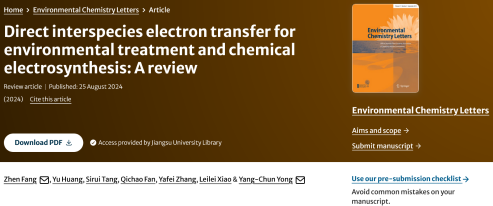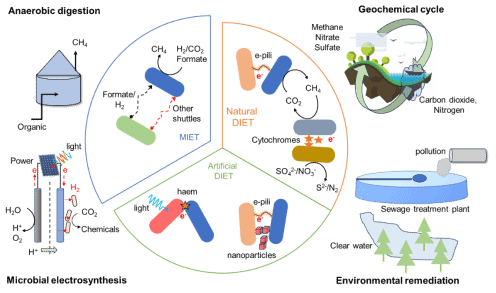Recently, our faculty and students published the latest review paper "Direct interspecies electron transfer for environmental treatment and chemical electrolysis: A review" online in the journal Environmental Chemistry Letters (2023 Impact Factor 15). Jiangsu University is the first completion unit, our teacher Fang Zhen is the first author and correspondence author, our researcher Yong Yangchun from the Institute of Biomass Energy Research is the co correspondence author, and Xiao Leilei, associate researcher from Yantai Institute of Coastal Zone Research, Chinese Academy of Sciences, is the participating author.


In this review paper, we provide a detailed review of natural interspecies electron transfer cases and the latest cases of "artificially designed" interspecies electron transfer in microbial electro symbiotic processes. Among them, the laboratory co culture of electroactive bacteria (such as methanogens, Geobacter, and photosynthetic bacteria) using the artificial DIET mode is an excellent case for exploring the DIET mechanism in depth. Research has found that conductive proteins, nanomaterials, or light assisted electron transfer pathways contribute to DIET and are the fundamental pathways that dominate efficient microbial electron transfer. This article also reviews the natural evidence and environmental significance of DIET. The results indicate that microbial electro synthesis through direct interspecies electron transfer is the main contribution of methane production, alkane oxidation, and geochemical cycling in nature. The methane produced by DIET between electroactive bacteria and methanogenic bacteria is not only an important biofuel, but also a potential greenhouse gas that poses a huge threat to the environment. Therefore, new applications such as methane oxidation, pollutant removal, and chemical electro synthesis can be developed through artificial DIET modes with electro synthesis capabilities. Microbial symbiosis dominated by DIET will have very promising application prospects. This review is expected to provide direction for the development of new microbial symbiotic models such as methane oxidation, geochemical cycling, environmental remediation, chemical electro synthesis, and energy storage. This research achievement has received funding from the National Key Research and Development Program and the National Natural Science Foundation of China.
Article link: https://doi.org/10.1007/s10311-024-01774-8